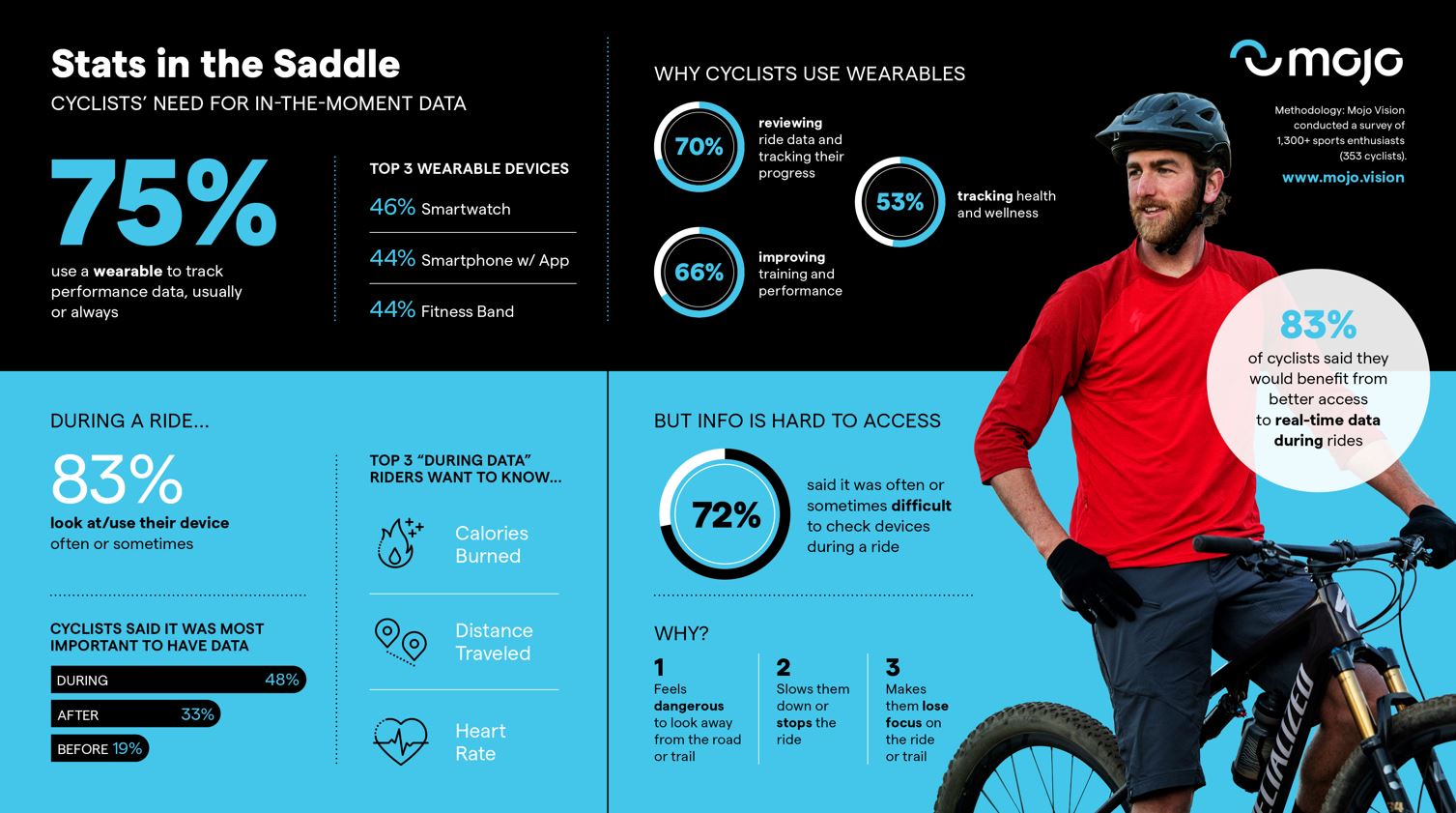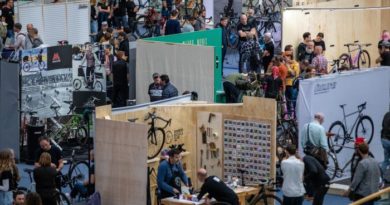How a smart contact lens could deliver cycling data in real time
CI.N has reported on a few occasions recently about the rise of wearable technology. When we spoke with one of Tyme Wear’s founders about their smart shirt that seemed like cutting edge stuff. Well, if that seemed like state of the art, then Mojo Vision, with its Mojo contact Lens, is in literal sci-fi territory.
Mojo Lens is a “smart contact lens with a built-in display that gives you timely information without interrupting your focus.” It is, in effect, a teeny-tiny dashboard type display in a contact lens – if we can get through this without referencing Minority Report then medals all round!
We spoke with David Hobbs, Senior Director Product Management at Mojo Vision. He joins us from San Jose, in the San Francisco Bay area. We start off only mildly envious.
Mojo: through the looking the Lens
David tells us Mojo was born out of one man’s quest to gift himself the vision of the “six-million-dollar man”. Drew Perkins, CEO and Co-founder is a serial entrepreneur. He has co-founder status at several internet startups, much of them in the ‘back end’ sphere. We’re also told we owe him for the not-insignificant part he played in establishing peer-to-peer (P2P) networking.
After selling off his previous company, he had surgery to correct the cataracts he’d developed. Though fixed, Drew found he now required reading glasses. For most of us, this might involve a quick trip to Specsavers to pick up some new specs. But, for a Silicon Valley based tech-entrepreneur a 2-4-1 offer on frames and lenses isn’t sufficient. Instead, Drew set about on a quest to not only fix his eyesight, but to afford himself the bionic vision of the six-million-dollar man.
We’re told that any quest to give oneself ‘bionic-eyes’ simply must begin with speaking with Dr Michael Deering – now Mojo’s Chief Scientist. Dr Deering has been working on VR related systems since the 1970s, so is literally one of the pioneers in this field. After his retirement, fishing and gardening (at least not IRL) obviously weren’t going to cut. Instead, he set about trying to understand how to make the world’s most efficient display. He spent years researching how vision works and what would be required to do this. Serendipitously, Drew and Dr Deering found each other. They talked through their ‘visions’ (pun absolutely intended) and how it could work. They came to realise that between them the future could be brought forwards several decades. Completing the tri-founder relationship is CTO Mike Weimer. Another serial entrepreneur with nothing better to do than bring the future 50 years forward.
Since its founding in 2015, Mojo has far exceeded the original hope of ‘six million dollar’ vision and raised in the region of $205 million in investment. Even adjusted for inflation, at $37,675,945.95 Drew has far exceeded his original hope, but quite clearly the thirty seven million, six hundred and seventy fie thousand, nine hundred and forty five dollar and ninety five cents man isn’t as catchy. A side note, the Walt Disney investment fund is now a significant backer.
The Mojo Vision
 “We really see AR (augmented reality) – at least immediately – to be a great opportunity to take something like a wearable that’s on your wrist and transform that into something that can keep you more eyes up and more focused on the world around you”, David tells us. This is a frequent sentiment re-visited throughout our conversation. The Mojo Lens, it’s hoped, will reduce the information we are seeing in our normal day to day lives. Only presenting what’s needed and reducing distractions.
“We really see AR (augmented reality) – at least immediately – to be a great opportunity to take something like a wearable that’s on your wrist and transform that into something that can keep you more eyes up and more focused on the world around you”, David tells us. This is a frequent sentiment re-visited throughout our conversation. The Mojo Lens, it’s hoped, will reduce the information we are seeing in our normal day to day lives. Only presenting what’s needed and reducing distractions.
“We want to reduce the overall distraction that technology can provide us. When I’m out on the trails on the mountain bike, I just want to be concentrating on the trail. I don’t want to stop the ride and pull out my phone to check where I need to go.” We can’t help but agree with David.
Although the applications to the wider population are clear, Mojo has worked heavily with sport and athlete partners (hence this article). Mojo have established several strategic partnerships across a host of fitness brands including Adidas Running, Wearable X (yoga), Slopes (snow sports), 18Birdies (golf) and most pertinently for us Trailforks for cycling. With these partnerships Mojo aims to use their market expertise to understand and offer the right data for athletes of varying disciplines.
For example, via Slopes David tells us they learned “the most important thing people want to know is ‘where are my buddies on the mountain?’” And “one of the really interesting things we learnt [through Trailforks], especially with mountain biking, is there is a real desire to get simple directions. Trails, even if well maintained, might not be well marked. So, we hear from people saying, ‘I thought I was on a trail, so I’d gone down the mountain, only to have to go back up it to get back on the correct trail.’” With the Mojo contact lens trail seekers could have simple arrow directions in their field of vision, negating the need to look down at a cycling computer when zipping down a narrow trail at warp speed.
On the road-side of course “power is really important to people for pacing up a climb and training… but again, also just being able to have turn by turn directions wherever you’re looking. We think this makes it safer for people cycling in cities and built-up environments allowing you to keep your eyes up on the traffic.”
One of the more gnarly features being worked on is being able to see airtime while mountain biking. “At the moment,” says David, “we’re at the stage of ‘yeah that would be cool, how do we do that?’”
It’s this focus on sports and training that Mojo hope to set themselves apart where products like Google Glass has failed to gain traction. Cyclists are a key use case that have been identified through a series of studies – 300+ cyclists and 1,300 sport enthusiasts – that are particularly amenable to displaying more data all the time.
How it works
The system itself is made up of two lenses. Both of which will correct your vision. The most important thing in the lens is the display. “I think we legitimately have one of the coolest teams in the world working on the display. They’ve made a screen about the size of a grain of sand, with a 300 x 300 pixel display. The display gives us the information that you’ll see from Mojo Lens” says David.
The display itself is effectively invisible. It is physically so close to the eye that you would never be able to focus on it directly. There is a tiny projection optic on the display that projects the emitted light onto your retina in such a way that it looks as if you are seeing content displayed at a comfortable viewing distance, superimposed on whatever you are looking at in the real world. This is important as it means your eyes won’t be strained viewing it, as they can be on AR glasses.
To receive notifications and updates, it has to be connected to the internet like any wearable. This means the first-generation lens will need to be paired with a smartphone, but since Mojo Lens is a device for the future, who knows if that will evolve over time. David describes this relationship as your device acting like an ‘air traffic controller’ or a relay between you and the lens. In between the two, a small wearable accessory is required. This might be something you’d put on your hand or wrist or have sitting under your clothes. This provides the wireless protocol that feeds into the lens. The lens itself – for obvious reasons – has only a small processer, so the additional wearable provides extra processing power.
By using the motion in your eyes you’ll be able to pull up certain information. There’s a small image sensor, which can detect what you’re looking at and so modify what is being displayed. “It could understand when I’m looking at a bunch of letters, so a book for example. The question then is ‘so I’m reading, do I want start seeing a bunch of notifications from a department store? Probably not. But if it was from a family member that would be more relevant right? If there was a steering wheel in front of me, we’d make sure we aren’t hitting you with a bunch of options. It should very much be passive information consumption.”
Importantly, from an ethical perspective David assures us, the device isn’t recording your movements. This isn’t a smart type device that is ‘always watching/listening’. This is “very much a closed system, that is using very rudimentary onboard technology that isn’t sharing.”
Since this is a scleral lens that rests on the white of your eye, it’s expected that people would be able to wear them for between one and one and a half years. Storing them each night in a special case that’ll clean and re-charge the contact lens.
Where are you now?
“If you’d ask me a few years ago, when we’d have wearable lenses, I’d have said 50 years, right? But now we’ve had a couple dozen people wear it already. We’ve been working on this as an incorporated company for six years, but we think this is far greater than the number of years to get out a product. We think we’re another few years out at this point.”
Being a contact lens and a medical product there’s a complex process to gain regulatory approval – any medical-device regulatory professionals out there then here’s your chance to help invent the future of Invisible Computing.
“This year we are developing what we call a ‘feature complete lens’. There’s a ton of new features we’re adding in like medical grade batteries that’ll charge the device as opposed to wireless; we have a bunch of IMUs in the lens, to be able to understand where the eyes are moving, and all the information is held and displayed nice and crisply in front your eyes; and we have some new protocols from an IC for wireless data. These are all be integrated right now, which we think should give us an idea for what we want to submit to regulatory bodies for approval.”
Business Model
Around 60% of people in the US are already wearing some sort of corrective contact lens. While current AR glasses frequently don’t work as actual glasses. Mojo sees these people as being its primary market and a mean to “give those people a sort of ‘superpower’.”
In the US, at least, this means it will be classes as a medical device, which needs to be prescribed by optometrists.
All in all, this looks like a potentially ‘game changing’, the progress of which we’ll follow avidly. And look at that. Not a single reference to Minority Report. Back pats all round!




